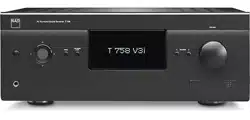Loading ...
Loading ...
Loading ...

ENGLISH
25
EARS
Two-channel recordings, whether stereo or surround-encoded, are
reproduced with proprietary NAD surround processing with signal output
to the front left/right, center and discrete left/right surround channels,
plus subwoofer (assuming these are present in the current “Speaker
Conguration”). EARS does not employ the surround back speakers (if any).
EARS extracts the natural ambience present in nearly all well-produced
stereo recordings. It does not synthesize any ambience or other sonic
elements and thus remains truer to the sound of the original musical
performance than most other music-surround options.
Select EARS for listening to stereo music recordings and broadcasts.
EARS produces a subtle but highly natural and believable ambience from
nearly all “natural-acoustic” stereo recordings. Typically, these include
classical, jazz, and folk genres as well as numerous examples from others.
Its virtues include realistic, stable “front-stage” sonic imaging and spacious
but unexaggerated ambient “virtual acoustics” that remain faithful to the
original recording.
ENHANCED STEREO
All recordings are reproduced in stereo via the maximum speaker
complement congured in the current “Speaker Conguration”. Enhanced
stereo can be useful for maximum volume from all channels or for multi-
speaker background music (cocktail party) listening. For this mode, Front,
Center, Surround and Back speakers can be turned ON/OFF as desired.
ANALOG BYPASS APPLICABLE ONLY WHEN THE SOURCE
SELECTED IS 7.1 CHANNEL INPUT DEFAULTED TO SOURCE 7
All analog signals remain in the analog domain without analog-to-digital
conversions. At Analog Bypass, the DSP circuitry is bypassed but full tone
control functions remain. “Bass management” or Speaker settings are also
not in eect as these are DSP functions.
DOLBY ATMOS
Dolby Atmos redenes your entertainment experience. Overhead
dimension is added by creating a full audio atmosphere and realistically
depicting objects moving overhead. Sound from a helicopter, a car
screeching around a corner or a melodic bird call can be precisely placed
and moved anywhere in your room, including overhead, to ow above
and around you in three-dimensional space. Dolby Atmos also renders
everything from dialogue to quiet scenes to whirlwind action with
astonishing clarity, richness, detail and depth.
DTS:X
DTS:X places sound where it would occur naturally in space, creating the
most lifelike, multi-dimensional audio experience ever. DTS:X technology
adapts to the viewing environment, allowing for a exible speaker
conguration that best ts the viewing space. Through the use of object-
based audio, DTS:X technology is able to scale immersive soundtrack
presentations across a wide range of playback systems, from ecient to
extravagant, while staying true to the content creator’s vision.
Neural:X
Neural:X™ is the latest spatial remapping engine from DTS, enabling an
immersive, multidimensional experience from legacy content. It is included
inside of DTS:X to provide upmix of Neural:X-encoded and non-encoded
(PCM) data. With DTS Neural:X, stereo, 5.1 or 7.1 content can be upmixed to
take full advantage of all speakers in your surround sound system.
DOLBY SETUP
Dynamic Range Control: You can select the eective dynamic range
(subjective range from soft to loud) for playback of Dolby Digital
soundtracks. For fully cinematic eect, always select 100%, the default.
Settings of 75%, 50%, and 25% progressively reduce dynamic range,
making soft sounds comparatively louder while limiting the peak
loudness of loud ones.
The 25% setting will yield the least dynamic range and is best for late-
night sessions or other times when you wish to retain maximum dialog
intelligibility while minimizing overall volume levels.
For Dolby TrueHD sources, set the Dynamic Range Control to “Auto”.
Center Spread: Center image is spread into the Left and Right
speakers. It is designed to complement musical content or to spread
the dialogue more evenly across a wide screen display.
On: Center Spread function is enabled.
O: Center Spread function is disabled.
DTS SETUP
Dynamic range control and dialog content can be congured at DTS Setup
menu.
Dynamic Range Control: This is the same congurable Dynamic
Range Control feature as described above at Dolby Setup, the only
dierence being the soundtrack is now in DTS format.
Dialog Control: Dialog levels are adjusted. Dialog control is more
than just adjusting center channel level as the center channel may also
contain other sound elements that get raised or lowered along with
the dialog.
NOTE
Dialog control applies only for playback of DTS:X content that supports
DTS Dialogue Control feature.
ENHANCED STEREO
Please refer to the same description of ENHANCED STEREO under “LISTENING
MODES”.
OPERATION
USING THE T 758 SETUP MENU
Loading ...
Loading ...
Loading ...
